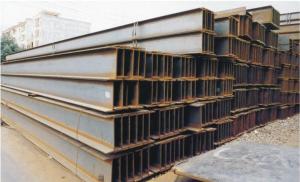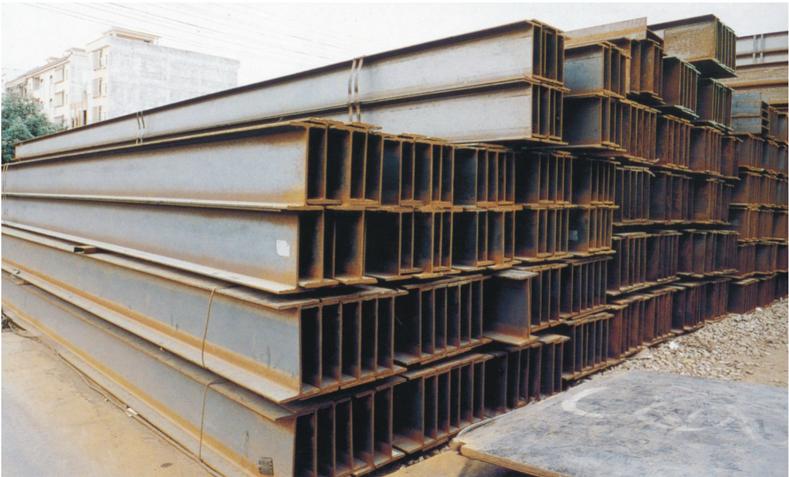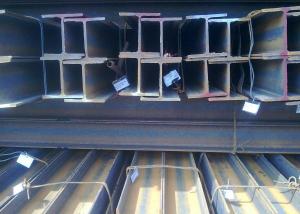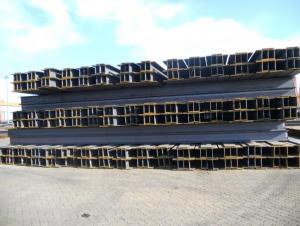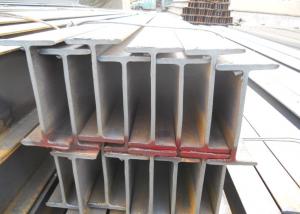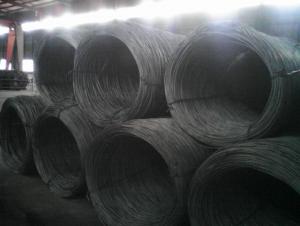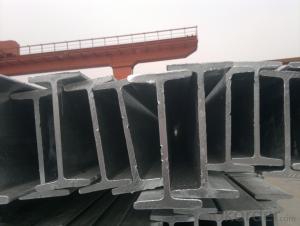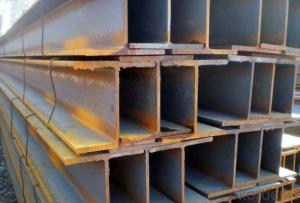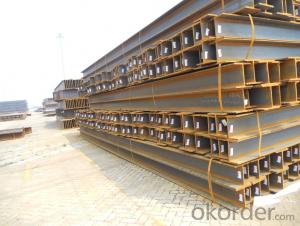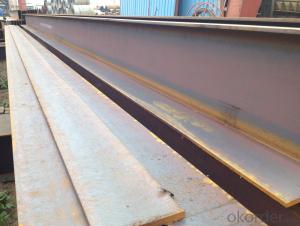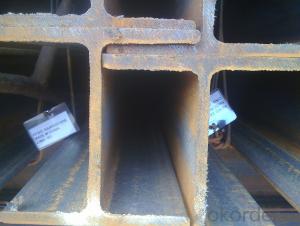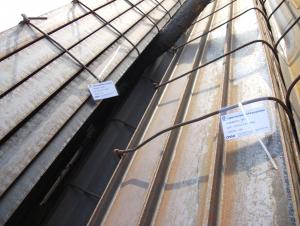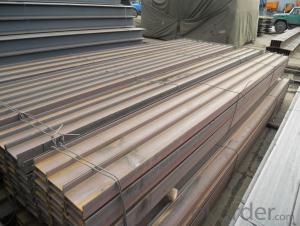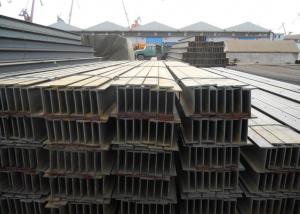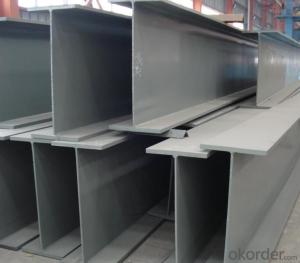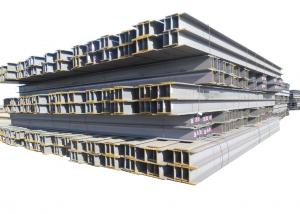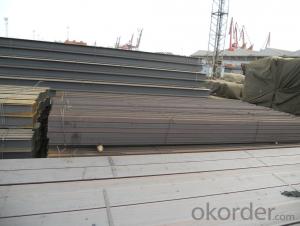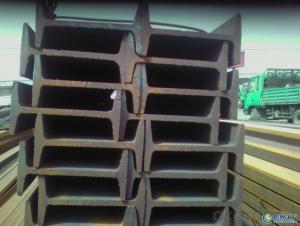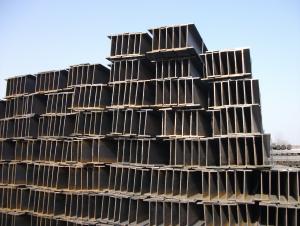Hot Rolled Carbon Steel H Beams
- Loading Port:
- China Main Port
- Payment Terms:
- TT or LC
- Min Order Qty:
- 100 m.t.
- Supply Capability:
- 10000MT m.t./month
OKorder Service Pledge
OKorder Financial Service
You Might Also Like
Product Description:
OKorder is offering Hot Rolled Carbon Steel H Beams at great prices with worldwide shipping. Our supplier is a world-class manufacturer of steel, with our products utilized the world over. OKorder annually supplies products to African, South American and Asian markets. We provide quotations within 24 hours of receiving an inquiry and guarantee competitive prices.
Product Applications:
Hot Rolled Carbon Steel H Beams are ideal for structural applications and are widely used inindustrial plants, civil construction, municipal works, oil platforms, bridges, flatbed beams, electrified railway power stand, railway bridges and other light steel structure, super-light H-beam is ideal for containers, mobile homes , all kinds of garage, box-type trains, electrical bracket, various venues, small villa manufacturing etc.
Product Advantages:
OKorder's Hot Rolled Carbon Steel H Beams are durable, strong, and wide variety of sizes.
Main Product Features:
· Premium quality
· Prompt delivery & seaworthy packing (30 days after receiving deposit)
· Can be recycled and reused
· Mill test certification
· Professional Service
· Competitive pricing
Product Specifications:
Manufacture: Hot rolled
Grade: Q195 – 235
Certificates: ISO, SGS, BV, CIQ
Length: 12m, as per customer request
Packaging: Export packing, nude packing, bundled
| H BEAM | ||||||
| size | h (MM) | b (MM) | t1 (MM) | t2 (MM) | Mass: Kg/m | LENGTH |
| 100x100 | 100 | 100 | 6.0 | 8 | 16.9 | 12M |
| 125x125 | 125 | 125 | 6.5 | 9 | 23.6 | 12M |
| 150x75 | 150 | 75 | 5.0 | 7 | 14.0 | 12M |
| 148x100 | 148 | 100 | 6.0 | 9 | 20.7 | 12M |
| 150x150 | 150 | 150 | 7.0 | 10 | 31.1 | 12M |
| 175x90 | 175 | 90 | 5.0 | 8 | 18.0 | 12M |
| 175x175 | 175 | 175 | 5.0 | 11 | 40.4 | 12M |
| 198x99 | 198 | 99 | 4.5 | 7 | 17.8 | 12M |
| 200x100 | 200 | 100 | 5.5 | 8 | 20.9 | 12M |
| 194x150 | 194 | 150 | 6.0 | 9 | 29.9 | 12M |
| 200x200 | 200 | 200 | 8.0 | 12 | 49.9 | 12M |
| 200x204 | 200 | 204 | 12.0 | 12 | 56.2 | 12M |
| 248x124 | 248 | 124 | 5.0 | 8 | 25.1 | 12M |
| 250x125 | 250 | 125 | 6.0 | 9 | 29.0 | 12M |
| 244x175 | 244 | 175 | 7.0 | 11 | 43.6 | 12M |
| 250x250 | 250 | 250 | 9.0 | 14 | 71.8 | 12M |
| 250x255 | 250 | 255 | 14.0 | 14 | 81.6 | 12M |
| 298x149 | 298 | 149 | 5.5 | 8 | 32.0 | 12M |
| 300x150 | 300 | 150 | 6.5 | 9 | 36.7 | 12M |
| 294x200 | 294 | 200 | 8.0 | 12 | 55.8 | 12M |
| 294x302 | 294 | 302 | 12.0 | 12 | 83.4 | 12M |
| 300x300 | 300 | 300 | 10.0 | 15 | 93.0 | 12M |
| 300x305 | 300 | 305 | 15.0 | 15 | 105.0 | 12M |
| 346x174 | 346 | 174 | 6.0 | 9 | 41.2 | 12M |
| 350x175 | 350 | 175 | 7.0 | 11 | 49.4 | 12M |
| 340x250 | 340 | 250 | 9.0 | 14 | 78.1 | 12M |
| 344x348 | 344 | 348 | 10.0 | 16 | 113.0 | 12M |
| 350x350 | 350 | 350 | 12.0 | 19 | 135.0 | 12M |
| 396x199 | 396 | 199 | 7.0 | 11 | 56.1 | 12M |
| 400x200 | 400 | 200 | 8.0 | 13 | 65.4 | 12M |
| 400x300 | 400 | 300 | 10.0 | 16 | 105 | 12M |
| 388x402 | 388 | 402 | 15.0 | 15 | 140 | 12M |
| 394x398 | 394 | 398 | 11.0 | 18 | 147 | 12M |
| 400x400 | 400 | 400 | 13.0 | 21 | 172 | 12M |
| 400x408 | 400 | 408 | 21.0 | 21 | 197 | 12M |
| 414x405 | 414 | 405 | 18 | 28 | 232 | 12M |
| 428x407 | 428 | 407 | 20 | 35 | 283 | 12M |
| 458x417 | 458 | 417 | 30 | 50 | 415 | 12M |
| 498x432 | 498 | 432 | 45 | 70 | 605 | 12M |
| 446x199 | 446 | 199 | 8 | 12 | 65.1 | 12M |
| 450x200 | 450 | 200 | 9 | 14 | 74.9 | 12M |
| 440x300 | 440 | 300 | 11 | 18 | 121 | 12M |
| 496x199 | 496 | 199 | 9 | 14 | 77.9 | 12M |
| 500x200 | 500 | 200 | 10 | 16 | 88.2 | 12M |
| 506x201 | 506 | 201 | 11 | 19 | 102 | 12M |
| 482x300 | 482 | 300 | 11 | 15 | 111 | 12M |
| 488x300 | 488 | 300 | 11 | 18 | 125 | 12M |
| 596x199 | 596 | 199 | 10 | 15 | 92.5 | 12M |
| 600x200 | 600 | 200 | 11 | 17 | 103 | 12M |
| 606x201 | 606 | 201 | 12 | 20 | 118 | 12M |
| 582x300 | 582 | 300 | 12 | 17 | 133 | 12M |
| 588x300 | 588 | 300 | 12 | 20 | 147 | 12M |
| 594x302 | 594 | 302 | 14 | 23 | 170 | 12M |
| 692x300 | 692 | 300 | 13 | 20 | 163 | 12M |
| 700x300 | 700 | 300 | 13 | 24 | 182 | 12M |
| 792x300 | 792 | 300 | 14 | 22 | 188 | 12M |
| 800x300 | 800 | 300 | 14 | 26 | 207 | 12M |
| 890x299 | 890 | 299 | 15 | 23 | 210 | 12M |
| 900x300 | 900 | 300 | 16 | 28 | 240 | 12M |
| 912x302 | 912 | 302 | 18 | 34 | 283 | 12M |
FAQ:
Q1: Why buy Materials & Equipment from OKorder.com?
A1: All products offered byOKorder.com are carefully selected from China's most reliable manufacturing enterprises. Through its ISO certifications, OKorder.com adheres to the highest standards and a commitment to supply chain safety and customer satisfaction.
Q2: How do we guarantee the quality of our products?
A2: We have established an advanced quality management system which conducts strict quality tests at every step, from raw materials to the final product. At the same time, we provide extensive follow-up service assurances as required.
Q3: How soon can we receive the product after purchase?
A3: Within three days of placing an order, we will arrange production. The normal sizes with the normal grade can be produced within one month. The specific shipping date is dependent upon international and government factors, the delivery to international main port about 45-60days.
Images:
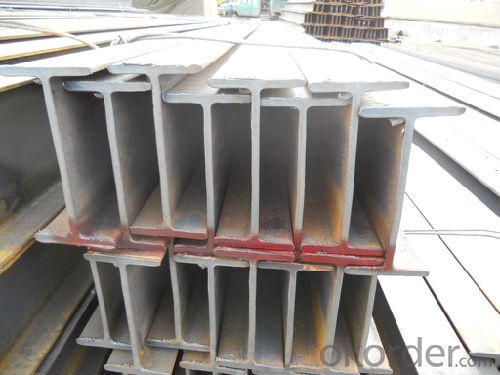
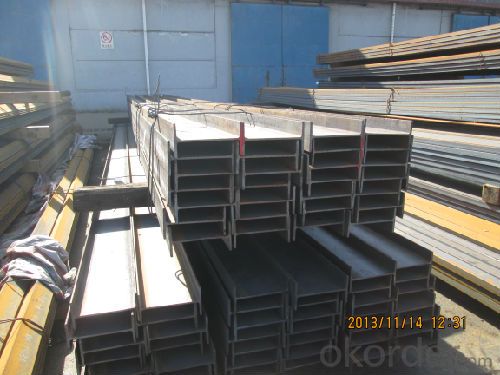
- Q: Are steel H-beams resistant to mold and mildew?
- No, steel H-beams are not resistant to mold and mildew.
- Q: What are the common factors that affect the cost of steel H-beams?
- The cost of steel H-beams can be affected by a multitude of factors. These factors include: 1. Raw material costs: The prices of the raw materials used to produce steel H-beams, such as iron ore and coal, can have a significant impact on the overall cost. Fluctuations in these material prices directly influence production costs and subsequently the selling price of the H-beams. 2. Manufacturing process: The manufacturing process of steel H-beams involves several stages, including melting, casting, rolling, and heat treatment. The efficiency and complexity of these processes can impact the cost. Technological advancements, energy consumption, labor costs, and equipment maintenance expenses all contribute to determining the overall manufacturing cost. 3. Market demand and supply: The demand and supply dynamics of steel H-beams can influence their cost. When demand is high and supply is limited, prices tend to be higher. Conversely, when demand is low and supply is excessive, prices may decrease. Factors such as market conditions, construction projects, and economic conditions all affect the demand and supply of steel H-beams. 4. Transport and logistics: The cost of transporting steel H-beams from the manufacturing facility to the customer's location can impact the final price. Factors such as distance, transportation methods, fuel prices, and handling charges all contribute to the overall cost. Additionally, import duties, taxes, and tariffs imposed by different countries can also affect the cost of steel H-beams. 5. Quality and specifications: The quality and specifications of steel H-beams can influence their cost. Higher-quality materials, superior finishes, and precise dimensions can result in higher prices. Furthermore, specific requirements such as custom sizes, lengths, or special coatings can increase production costs and, subsequently, the selling price. 6. Competition and market conditions: The level of competition in the steel industry can influence the cost of H-beams. Intense competition among manufacturers can lead to price wars and lower prices. Economic factors, global trade policies, and market trends also impact the cost of steel H-beams. It is essential to note that these factors may vary depending on geographic location, industry-specific requirements, and other external factors. As a result, the cost of steel H-beams can fluctuate over time due to changes in any or all of these factors.
- Q: How do steel H-beams contribute to the overall sound insulation of a building?
- Steel H-beams do not directly contribute to the overall sound insulation of a building. Sound insulation is mainly achieved by using materials with high sound transmission class (STC) ratings, such as acoustic insulation, double-glazed windows, and soundproof doors. Steel H-beams, being structural components, primarily provide support and stability to the building structure rather than contributing to sound insulation.
- Q: Can Steel H-Beams be recycled or reused?
- Yes, steel H-beams can definitely be recycled or reused. Steel is a highly recyclable material, and H-beams can be melted down and repurposed into new steel products. Recycling steel helps conserve natural resources and reduces the energy required for manufacturing new steel, making it an environmentally sustainable choice. Additionally, H-beams can also be reused in construction projects, either in their original form or after some modifications, contributing to a circular economy and minimizing waste.
- Q: Are steel H-beams resistant to chemicals or corrosive substances?
- Yes, steel H-beams are generally resistant to chemicals and corrosive substances due to their composition and protective coatings. However, the level of resistance can vary depending on the specific type of steel and the nature of the chemical or corrosive substance involved. It is important to consider the specific application and consult with experts to ensure proper corrosion protection measures are in place.
- Q: How do steel H-beams contribute to occupant comfort in buildings?
- Steel H-beams play a crucial role in enhancing occupant comfort in buildings through various mechanisms. Firstly, these beams provide structural stability and support, ensuring the overall integrity of the building. This stability reduces the risk of structural failures, which can lead to discomfort and safety concerns for occupants. Moreover, steel H-beams have high load-bearing capacity, allowing for larger spans and open floor plans. This flexibility in design enables architects to create more spacious and comfortable living and working areas without the need for excessive columns or supports, which can impede occupant movement and hinder the aesthetics of the space. Additionally, steel H-beams are known for their fire resistance and durability. In the event of a fire, these beams can withstand higher temperatures compared to other construction materials, ensuring the safety of occupants and minimizing the spread of flames. The structural strength of steel H-beams also contributes to the building's long-term durability, reducing the need for major repairs or renovations that can disrupt occupants' comfort. Furthermore, steel H-beams have excellent sound insulation properties, reducing the transmission of noise between different areas of the building. This feature is particularly important in multi-story buildings or those located in busy urban areas, where external noise can be a significant source of discomfort. The reduced noise levels contribute to a quieter and more peaceful environment for occupants, promoting their well-being and productivity. Lastly, the use of steel H-beams allows for efficient HVAC (Heating, Ventilation, and Air Conditioning) systems. With their lightweight nature and high strength-to-weight ratio, these beams enable the installation of ductwork, piping, and other HVAC components without excessive load-bearing concerns. This flexibility in HVAC design ensures optimal temperature control, ventilation, and air quality, contributing to occupant comfort and well-being. In summary, steel H-beams contribute to occupant comfort in buildings by providing structural stability, enabling open floor plans, offering fire resistance and durability, insulating against sound transmission, and facilitating efficient HVAC systems. These features collectively enhance the overall comfort and safety of occupants, creating a pleasant and enjoyable environment for living and working.
- Q: Hot rolled H section steel
- The flange width, lateral stiffness.The bending capacity, than the beam about 5%-10%.The two flange surfaces parallel to each other makes the connection, convenient manufacture and installation.We compared with welded I-beam with low cost, high precision, small residual stress, without expensive welding and weld testing, saving the cost of steel production is about 30%.The same section under load. The structure of hot rolled H steel than the traditional steel structure weight 15%-20%.We compared with the concrete structure, the structure of hot rolled H steel can be increased by 6% of the area, and the structure to reduce weight 20% to 30%, reducing the internal force of structure design.The H type steel can be processed into T type steel honeycomb beam can be formed by the combination of all kinds of section form, design and production greatly satisfy the engineering demand.
- Q: Can steel H-beams be used for airport terminals?
- Yes, steel H-beams can be used for airport terminals. Steel H-beams are commonly used in the construction industry for their strength and durability. They are capable of supporting heavy loads and providing structural stability, making them suitable for large-scale structures like airport terminals. Additionally, steel H-beams can be fabricated to various sizes and lengths, allowing for customized designs that meet the specific requirements of an airport terminal. Overall, steel H-beams are a popular choice in the construction of airport terminals due to their reliability and versatility.
- Q: In the steel structure, the semifinished product H steel column, whether also sets the manufacture quota?
- The cost budget is easy to miss 100 items. 1, in the flat roof insulation roof discharge hole2 embedded iron pieces in the stair railing3 scaffold for paint and coating construction4 precast slab beam concrete: plate, beam head concrete, transportation, installation5 bored pile: drilled into the depth of rock (the municipal and highway quota projects contain a great gap in content)6, the installation of indoor plumbing is easy to miss
- Q: What are the fire protection requirements for steel H-beams?
- The fire protection requirements for steel H-beams depend on various factors including the type of building, occupancy, and fire safety codes and regulations. However, in general, steel H-beams typically require fire protection to enhance their structural integrity in the event of a fire. The primary concern when it comes to fire protection for steel H-beams is preventing the steel from reaching its critical temperature, which can weaken the structural integrity of the beams. Fire protection measures are implemented to delay the heating of steel H-beams and prevent their premature failure during a fire. One common method of fire protection for steel H-beams is the application of fire-resistant coatings. These coatings are specifically designed to insulate the steel and delay its temperature rise by creating a barrier between the steel and the fire. Fire-resistant coatings can be applied to the exposed surfaces of the H-beams, providing a protective layer that slows down the transfer of heat to the steel. Another method of fire protection for steel H-beams is the use of fire-resistant encasement. This involves enclosing the H-beams within fire-rated materials, such as gypsum boards or concrete, to provide a physical barrier against the fire. The encasement acts as a shield, preventing direct exposure of the steel to the flames and heat. The fire protection requirements for steel H-beams will vary depending on the specific fire safety codes and regulations in place. These requirements may specify the type and thickness of fire-resistant coatings or encasement, as well as the duration of fire resistance required. It is important to consult with a qualified fire protection engineer or local fire safety authorities to determine the specific fire protection requirements for steel H-beams in a particular building or project. Compliance with these requirements ensures the safety and structural stability of the building in the event of a fire.
Send your message to us
Hot Rolled Carbon Steel H Beams
- Loading Port:
- China Main Port
- Payment Terms:
- TT or LC
- Min Order Qty:
- 100 m.t.
- Supply Capability:
- 10000MT m.t./month
OKorder Service Pledge
OKorder Financial Service
Similar products
Hot products
Hot Searches
Related keywords
